Vol. 1, Iss. 13: The Nerd-letter Issue
Looking at 3 mock off-season scenarios, while explaining all the nerdy stuff that is about to come up during a condensed trade, draft & free agency window.
Um, The NBA Is Nearly Back….
So…. so am I. And so are you it seems! The key NBA off-season dates are some of my favorite dates on the calendar. These are now virtually all locked in, and therefore I will be locked in to producing more Newsletter Issues in the lead up to the start of the season. Help me reach my goal of 1,000 subscribers before the next NBA season starts, by hitting the button below or telling your friends to.
Let’s get nerdy…..
Let’s start with those dates, shall we?
November 15th(ish) - Trade Window Open
November 18th - NBA Draft
November 20th - Free Agency Begins
December 1st - Training Camp
December 22nd - NBA Season Start.
Talk about action packed!
For those of you who listened to my old 7SOL podcast, you’d know the NERDCAST episode was one of our best. So I have decided to resurrect it again in written form but with a twist! I know a lot of this stuff can be a little dry, so we are going to look at 3 mock off-season scenarios using the 3 options put forward in Issue 7.
While I am going to explain a lot of the tricky CBA terms along the way, I am going to also put my balls on the line and predict what the Suns might do. Maybe I’ll nail a whole scenario, hopefully I get at least one player right but very likely it all ends up being very wrong.
No matter what happens in a few weeks time, I hope you’ll learn something below or love/hate some of the player suggestions.
In the spirit of getting things wrong early, you will notice I have struck out Cheick Diallo, Elie Okobo and Tariq Owens in my cap sheet above. The Suns have some form of an option to bring all three back. But for the purposes of the below, I have ruled them all out. Perhaps I end up being wrong on one but I had to draw the line somewhere. As for the rest, they all stay in the cap sheet because they feature at least once each in the below scenarios.
Every cap sheet you see for the Suns will likely differ somewhat but mine should be consistent with others on at least a few things. The Suns guaranteed salary going into season 20/21 is $83.3mil. With options and holds, the team are over the salary cap set by the league. And they have avenues to create various amounts of cap space.
How much cap space exactly they can create, is where you’ll start to see mine and other sheets differ. For the records I keep, I believe the Suns can easily create between $7-$22mil in cap space to spend without any drastic trades etc.
But What Is The Salary Cap For 20/21?
Great question, imaginary friend subscriber! Normally the NBA salary cap is set by taking roughly 45% of the projected basketball related income (BRI) and dividing it among the 30 teams. However in this crazy world we currently live in where revenue is taking a huge hit, that would result in a HUGE dip in the salary cap. So instead, the league has agreed to set the number again at $109.14mil. The same as last season.
The main reason why we can’t then just take the Suns $83.3mil in guaranteed contracts and subtract it from the total salary cap to get their likely cap space, is because there are still other uncontracted players on Phoenix’s books. Three that are important to the Suns and the scenarios below are Aron Baynes, Dario Saric and Jevon Carter. Although they are technically free agents, they currently remain on the Suns sheet via what is called a cap hold.
What Is A Free Agent Cap Hold?
Another amazing question, you are rolling! This is essentially an estimate on the future salary for any FA’s you have on the books. So for Phoenix, you will see amounts in blue in the cap sheet above - for Baynes, Saric and Carter. The NBA has set rules for what the cap hold should be based on who the player is and their previous salary. Generally this will be an increase between 120-300%. Most importantly, that number is calculated as part of your teams salary until it’s replaced by the real salary number you sign them for or renounce them off your books.
The other noticeable cap hold taking up a few million dollars right now for the Suns, is their upcoming draft choice of #10 . Although we don’t know who that player is yet or whether Phoenix will even use it, there is an amount set aside for that contract already.
What’s The Difference For A Rookie Cap Hold?
These work much in the same way as the FA holds above. However, they only apply to first round picks and each year the amount is per-determined by what number pick you have and what the salary cap total ends up being. One common mistake made is ignoring that a Rookie Cap Hold is 120% of the amount in the rookie scale, until the player signs. For Pick 10, that’s currently $4.24mil. It’s very rare that lottery picks sign less for the 120% allowed, so if the Suns do take someone at #10 then you can be sure that’s the figure they end up earning in year 1.
So that should set the stage a little, for where the Phoenix Suns currently sit in mid November. But things are going to change very soon. And they have a number of options available to them, for which direction to take.
Below are just 3 possible scenarios. It by no means covers all possibilities but I do hope to map out some realistic options the team has, including how it would go down and which players the Suns might target.
#1 - Clearing Cap Space
You want to go big game fishing, huh?
The Suns have some very realistic ways to clear a significant amount of cap space and compete with just 5 other teams who will be operating in that market. It’s not quite “max” cap space to sign a max contract player, but those are also virtually non existent in this free agency period anyway. It’s also not the maximum they could create, if they really wanted to. For instance, they could make further cap clearing trades like dumping Kelly Oubre but I have avoided that for now.
So how do the Suns end up with this team? Well, the first key number is $22,270,579.
Phoenix can remove all non-guaranteed salaries and holds off their books and be left with 8 players; Ricky Rubio, Devin Booker, Mikal Bridges, Deandre Ayton, Cam Johnson, Ty Jerome, Jalen Lecque and Oubre. The salaries of those 8 will leave you with roughly $22mil to spend, after roster charges are incurred.
What Is A Roster Charge?
You are making it so much easier, with these questions. Thank you. I’ll cut to the chase on this one. The NBA wants all teams to employ AT LEAST 12 players at all times, out of the maximum of 15. They have a few different rules to encourage this. One being, that if you have under 12 players at any point during the off-season then you incur an incomplete roster charge. This acts like the cap holds above and cuts into your cap space. The charge is for the minimum salary (because you should at least have a minimum salary signing on your books) which is $898k this season.
So, how would I spend that money if I were the Suns?
I would target what I see as the two biggest holes in the current roster - starting PF and scoring off the bench. Let’s take the full $22mil and offer it to Davis Bertans and Justin Holiday.
Now it’s not exactly a Morris Twins type arrangement, where they decide among themselves who is getting what. As far as I know Bertans and Holiday are not related. But if we start with Holiday and assume we are going to be competing with teams who have the MLE (more on that later) to spend, then we need about $9mil set aside for him. That leaves us with a tick over $13mil to offer Bertans in year 1.
Is that enough? Honestly, who really knows in this upcoming market. But I am going to pretend that a 4 year deal totaling $55mil, plus the opportunity to start for the Suns is enough to bring Bertans to the Valley. AND he gets to wear that new jersey.
That deal would actually start at $12.79mil, which means the Suns would then have $9.48mil to offer Holiday. And would you look at that, it’s JUST more than the MLE. Therefore Holiday is willing to sign what I hope is a two year deal just shy of $20mil. He’s surprisingly 32 next season, so that should do it and you may even get some protection on that second year if you’re lucky.
Now we have to fill out the roster and we still have 5 open roster slots.
Let’s go with Jeff Bower favorite, Langston Galloway as another guard off the bench. Despite being out of cap space now, we are going to sign him using some or all of the Room Exception.
What Is The Room Exception?
Remember how the Suns signed Frank Kaminsky last season? Yeah me too *shudder*. They did so despite having used all their cap space already. The Room Exception is one of many exceptions the NBA provides for teams to still sign players despite being out of cap space. This one is available to any team that uses up their cap space this off-season. The reason I mentioned Frank is because if the salary cap hasn’t changed, then neither has the amount of the Room Exception. So the Suns would be able to offer two years total for $9.7 million. And yes, it can be split across several players if you like.
Now if Galloway’s agent demands all the Room Exception, then we are only left with a Veteran Minimum contract to offer another target - Nerlens Noel. Noel as Ayton’s backup C partner would be a nice look. And while it seems a little fortuitous to pin him down for the minimum, it’s a rough off-season to be a FA and Noel has really only signed similar deals in recent history.
How Do Veteran Minimum Deals Work?
Don’t make me get too nerdy with you, dear subscriber! But Vet Min deals are probably my favorite CBA related quirk. Firstly, they can only be two years max. Secondly, the amounts are again tied to what the salary cap total is and the number increases based on years of service in the NBA. Thirdly, they don’t count against a teams salary cap when considering cap space. And finally, to encourage teams to keep vets around - the NBA actually reimburses teams the difference between a minimum salary for a 3 year player and whatever the number is for the player being signed. So roughly a million dollar rebate if you sign a player with 10+ years service.
Where does the rest of the roster come from then?
Grant Riller - The Suns would have to trade out of the first round entirely to clear the space for scenario #1. Would Charlotte covet another top 10 pick in this draft and be willing to trade for a slightly protected first next year + #32? If Riller falls to the second round like most project, I’d LOVE him on the Suns.
Mike Muscala - The writing might be on the wall for Lecque, after the Suns sold their G League team, he signed with Klutch and the abundance of guards already on the roster. Maybe a rebuilding OKC would take the chance on him, in exchange for big man bench depth for the Suns.
Cam Payne/Carter - We had to renounce both of these guys to clear all that space but is it a stretch to think they’d still come back on minimum deals after not getting much love elsewhere on the open market? I don’t think so.
And there’s your 15.
#2 - Wheeling & Dealing
The next option has the Suns still playing with cap space, just a much smaller amount.
In order to improve the team further, they also get creative with a trade. This scenario might be the most realistic of the three, but also the hardest to predict on exactly what the moves will look like. There is some continuity with the roster, but we say goodbye to a favorite Sun in exchange for fixing some of the holes in the roster.
To create this next roster - let’s start again with who remains on the roster and where that leaves the cap space heading into free agency. The 10 Suns players you see in orange (and red) above, including Saric and Carter as cap holds, are on the books. Kelly Oubre’s salary makes 11, but he is not long for Phoenix under this scenario.
Phoenix also stuck at #10 in the draft and snatched Devin Vassell when he was still on the board. That makes 12 players (so no roster charges this time) and leaves 3 open slots to fill. A bit of work to do in November/December to get better.
It also leaves just $7,374,566 in available cap space to get it done, mainly because of the cap holds for Saric and Carter as they enter Restricted Free Agency.
How Does Restricted Free Agency Work?
Most FA’s are unrestricted and can sign wherever they want, whenever they want. Some are a little less free. RFA’s are typically first rounders coming off their rookie deal (Saric) or minimum deal signings with 3 or fewer seasons (Carter). To cut a very long story short, the team tends a Qualifying Offer (QO) to a RFA. This is a guaranteed contract for 1 more season with the team. This QO gives the existing team the right to match any contract the player goes and signs elsewhere. So the player has 3 main options - sign the QO for 1 season, sign an offer sheet elsewhere (that is either matched or not) OR reach a new longer agreement with the team.
In the interests of speeding things up a little here, we are going to suppose that the light FA market and interest from the Suns to lock this part of the roster up quickly - resulted in both Saric and Carter agreeing to new deals in Phoenix without signing an offer sheet elsewhere. I actually think that could be very likely and I could see something in the vicinity of 3 for $30mil for Dario and 2 for $5mil for Jevon.
The important thing to note here is whilst the deals have been agreed to, the Suns would wait to sign these officially until last in the order of transactions. That allows them to use their remaining cap space and sign these existing players over the cap.
Time to deal Kelly.
What Are The Rules Around Matching Salary In Trades?
Tricky one! Let’s stick with the rules for Non-Taxpaying teams. We are the Suns afterall, AMIRIGHT? First important point - if the team receiving more salary has the cap space to absorb that salary, then throw matching rules straight out the window. But if that’s not the case, then the following rules apply. If outgoing salary is no more than $6.53mil, then 175% of outgoing salary + $100k can come back. If it’s between that and $19.6mil, then it can be the outgoing salary + $5mil. Anything above that, then you can receive 125% + $100k. Make sense? Good.
The deal we are going to make here is to actually save the Suns some extra salary. We are targeting Spencer Dinwiddie and his $11.4mil salary. The Nets are likely not interested in Oubre though, so we need a third team - enter the New Orleans Pelicans.
Does a three teamer sending Jrue Holiday to Brooklyn, Dinwiddie to Phoenix and Oubre/Caris LeVert to NOLA make sense? I happen to think that’s the start of a pretty good core deal. Maybe you have to get creative with their respective picks (#10, #13, #19) and some lower salary players added in.
So by sending out Oubre’s $14.3mil for Dinwiddie, the Suns save almost an extra $3mil. The interesting thing about that is it takes them to $10.3mil in cap space, which is conveniently just a little bit more than the MLE (we go over that soon) that most other teams have to play with.
Why is that important? Because I think we can snatch a really good player with a long term offer that starts with that salary and increases from there.
How Much Can We Increase A FA’s Salary?
This is a good one for the Suns upcoming off-season. For our own FA’s, the answer is typically 8% raises. But for other FA’s we have attracted, the increase is slightly less at 5% raises. Another common mistake is taking the first year and adding the 5% increase year on year. The correct calculation is to increase the first year salary by 5% and then to increase every subsequent year by the same dollar amount increase that happened from year 1 to 2. See below.
Christian Wood, come on down!
Can the Suns woo Wood with a starting salary that is a little bit more than the MLE, which many have reported as his range? He could choose 2, 3 or 4 years depending on whether he wanted long term security or to re-enter FA when the market is stronger.
2 years: $10,295,000 + $10,809,750 = $21,104,750
3 years: $21,104,750 + $11,324,500 = $32,429,250
4 years: $32,429,250 + $11,839,250 = $44,268,500
I don’t LOVE the fit with Ayton to be honest, as I see them both predominantly as 5s going forward. But that’s only worth discussing further if Wood does suit up in The Valley jersey next season. What is kind of interesting though looking at those salaries, is they’d both make very similar money over the next two years. Then Ayton would likely command over double for years 3 and 4, while Wood could be locked in. Something to consider if he does sign and my suspicion on their roles ends up correct.
Filling out the remaining spots…
E’Twaun Moore - The Suns can use the Room Exception to sign Moore as an extra ball-handler and primary backup to Booker at SG. Moore would bring more veteran experience to the team and provide much needed depth.
Kyle O’Quinn - Using a Vet Min deal, Phoenix could also sign O’Quinn as a FA. The big bench depth is looking a little thin should anything go wrong, so using the last spot on an experienced big man makes the most sense.
#3 - Running It Back
I’m saving the least sexy option ‘til last, as many of you may have stopped reading by now.
This has the Suns bringing back every major piece from last season, adding around the fringes and remaining an ‘Over The Cap’ team. While it may seem boring on the surface, I’d point to my 7 ity-bity-reasons in Issue 7 as a compelling case for why it could be a wise move. Both from a making the Playoffs perspective AND being in an even better position to make a trade down the road.
Speaking of which, let’s talk trades quickly to start building the above team.
Under this scenario, the Suns would opt into the Team Option on Kaminsky in order to help stay over the cap. On draft night, we strike a deal with the Pelicans to shift back to #13 from #10 and exchange Frank for Josh Hart. It gives the Suns another good guard option, while Frank was looking like the odd man out. Similar to last draft, PHX slide back a few spots to take their target Desmond Bane in a slightly comfier range.
Can You Trade Players With Options (Off-Season & In-Season)?
Throwing me the hard ones now. I’ll deal with two scenarios here as quick as I can. In the off-season, a player cannot be traded if their option for next season hasn’t been exercised. So a team who has an option (Suns, Frank, Wink) must exercise it before trading that player. If it’s a non-guaranteed deal rather than an option, then that player can be traded if the guarantee date hasn’t come yet (Okobo). Importantly though, only their guaranteed salary can be used for salary matching in trades. The other scenario is in-season and options for the following year (Suns, Saric/Baynes, Wink). A team cannot trade certain players on 1 year deals (including options) without their permission. That is because of the impact on their Bird Rights, which we will go through below.
Being over the cap, the Suns can’t then go chasing any other free agents with cap space. So the next order of business is locking all their own free agents into contracts. That means Saric, Baynes and Carter. Given we may want to use them as trade assets during the season, my suggestion would be 1+1 deals where the next season salary is non-guaranteed and therefore you bypass the need for permission to make a trade.
Inflated salaries with an 8% raise could be enough to convince them all to sign back in PHX during a depressed market. Those could also come in handy when making trades in the future. How do they make that work legally? It all comes down to Bird Rights and spending Sarver’s cash. Nothing else matters.
How Do Bird Rights Work?
GREAT question. Also VERY hard question to keep short. I’ll do my best. If a player is on a team for 3 years without being renounced, he gains Bird Rights. To complicate it a little, that includes even if he was traded on the deal (Saric/Baynes). There is also a thing called Early Bird Rights for similar scenarios of 2 years (Carter now) or Non Bird for even weirder scenarios (maybe Carter if renounced). If the player becomes a FA (and team keeps their cap hold on the books), then they can be signed to a new deal OVER the salary cap. For full Bird Rights FA’s, the salary can be up to their max. For Early Bird it’s 175% of previous and for Non Bird it’s 125%.
Under this scenario, I’d want to make 1 more addition to the roster to sure up the play-making duties. But with no free money left to do so, we are left with two further salary exceptions the NBA provides.
I’m going to give as much of the MLE it takes to lure DJ Augustin to Phoenix. And I’ll even give the 33 year old a second year, if he wants it.
What Is The MLE and BAE?
We did it, last question! Last but not least perhaps. We spoke about the Room Exception early on and it’s availability to cap space teams. Well, the Mid Level Exception (MLE) and Bi-Annual Exception (BAE) are available to teams who want to sign more players but are already operating over the cap. Again, I’m ignoring the difference if you are a tax-paying team because Suns gonna Suns. Therefore, the MLE starts at $9.25mil in year 1, can be split among several players and be up to 4 years in length. The BAE starts at $3.62mil, can also be split but is only for 2 years. The key difference is the BAE can only be used every 2 years, which important when looking at the Suns future.
With 15 players already on the roster, we don’t need to make any last minute additions for this option. We don’t even use the BAE in the end, which we could save for next season or even during the season after a lopsided player trade perhaps.
So, What Do You Think?
Option 1, 2 or 3?
If you’ve made it this far then you’ve read more than enough, so I won’t go on with any long drawn out conclusions on what I think is the right move. I will just say that I can see the value in all 3 scenarios but still lean Option 3. I am also willing to admit that it’s probably the least likely. But the continuity it brings, along with the far greater flexibility to make a big trade down the track, is why it’s the choice I’d make.
Hopefully you found this useful. If you have any leftover CBA/Cap questions, just let me know. Would love to hear your thoughts or other ideas in the comments section below.
OT.
Just one item for over-time this week. I ran a fun off-season game with members of Suns Twitter, where you had to try predict who is going to land on the Suns.
You can see the rules and final rosters HERE.
Oh also, if you are interested in a lot of the nerdy stuff above I’d highly recommend CBA FAQ by Larry Coon for more details. It goes much more in depth and is basically the bible for all things CBA in the NBA.
Otherwise, I am more than happy to answer any further questions on Twitter or in the comments below. Thanks!


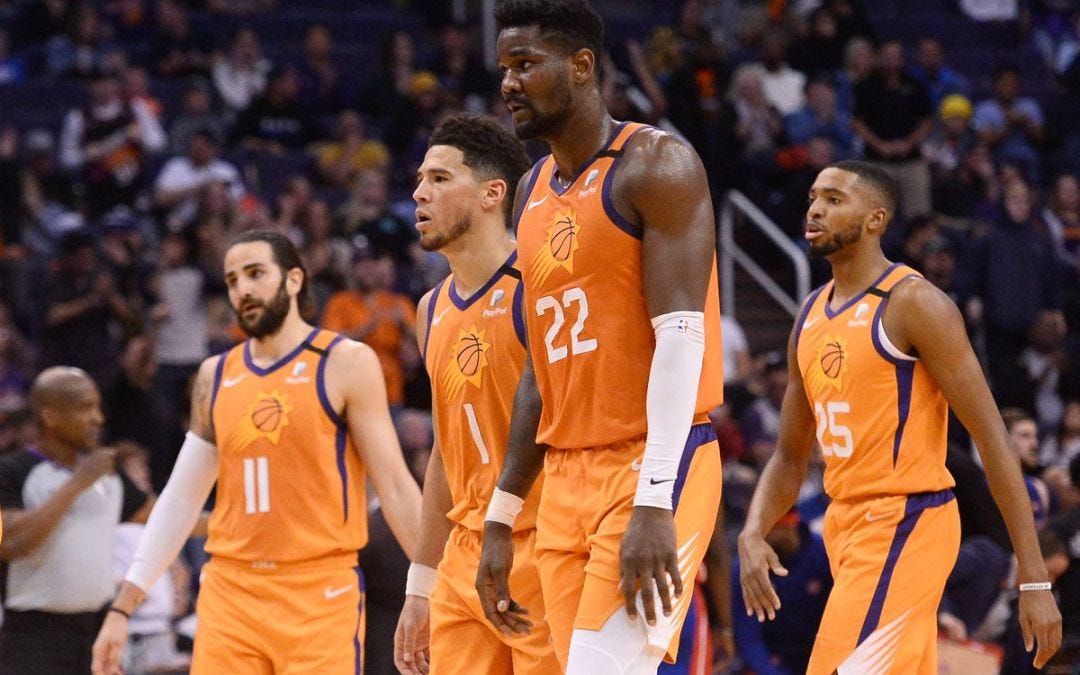
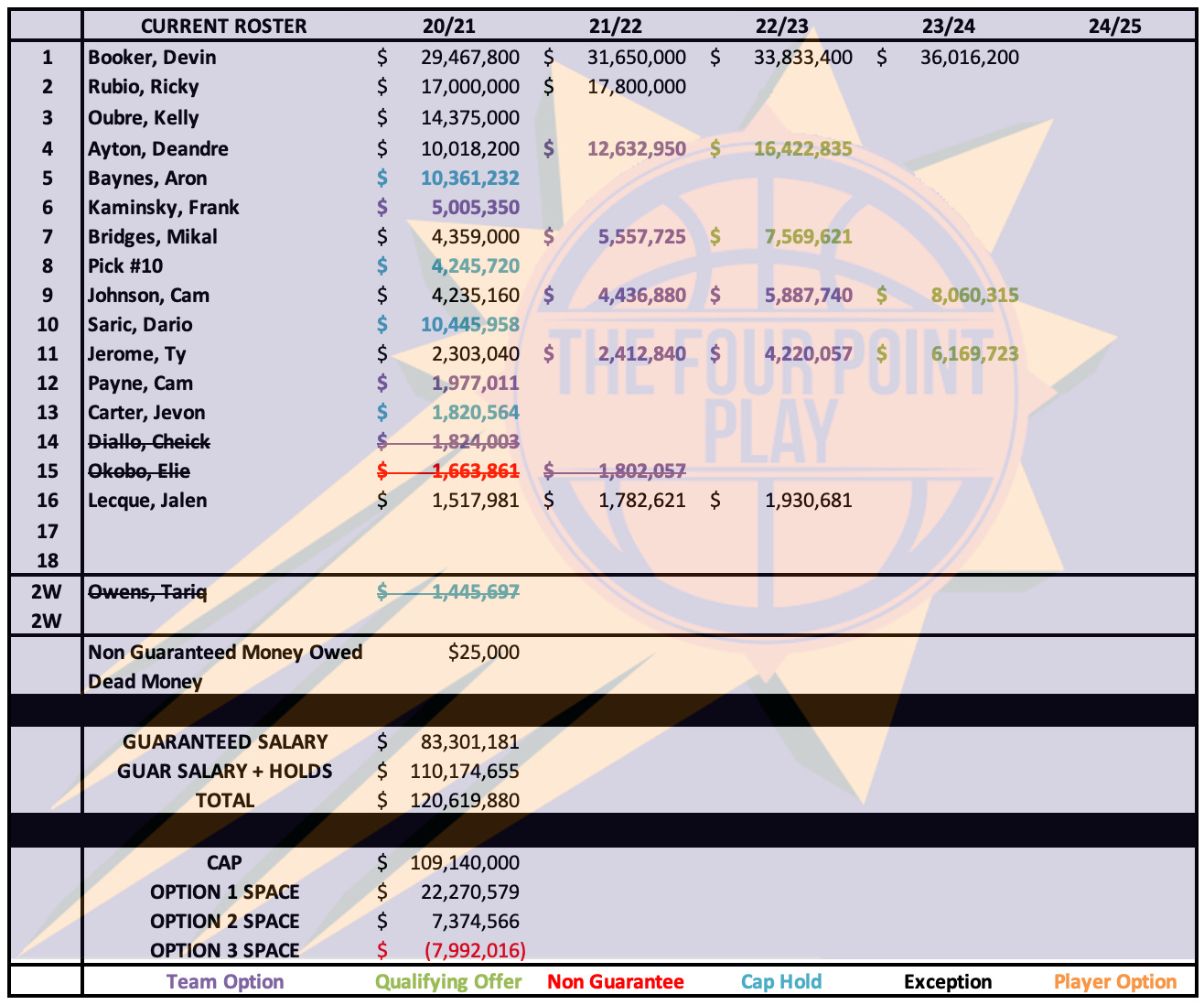
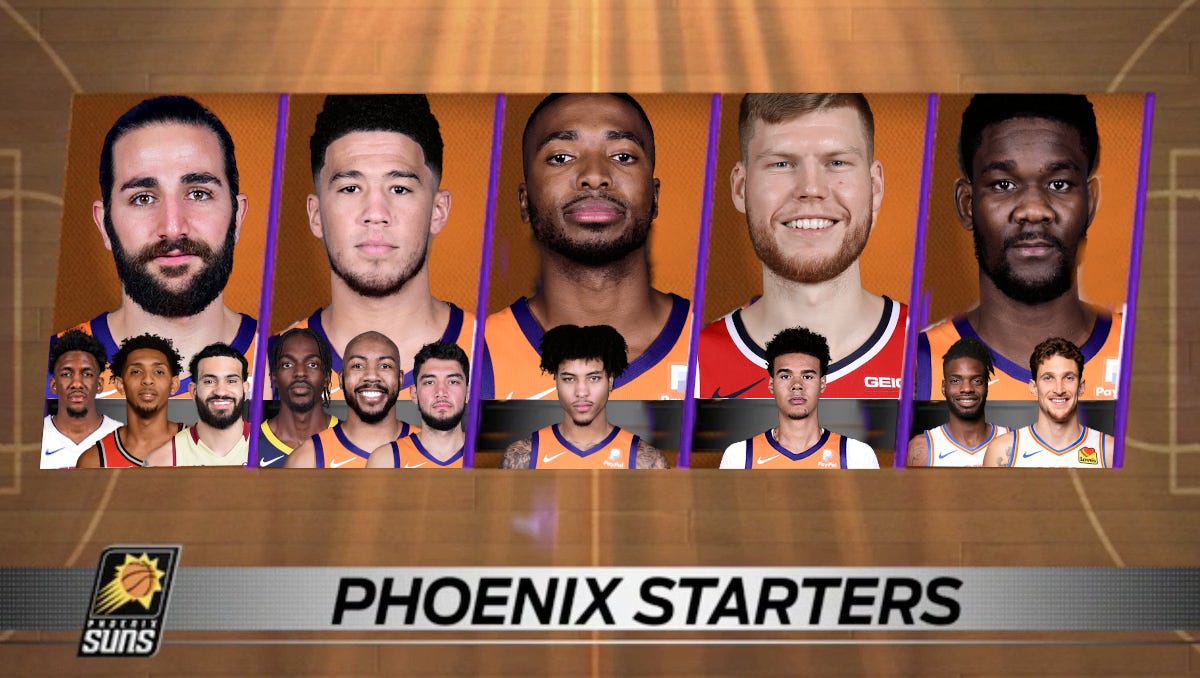
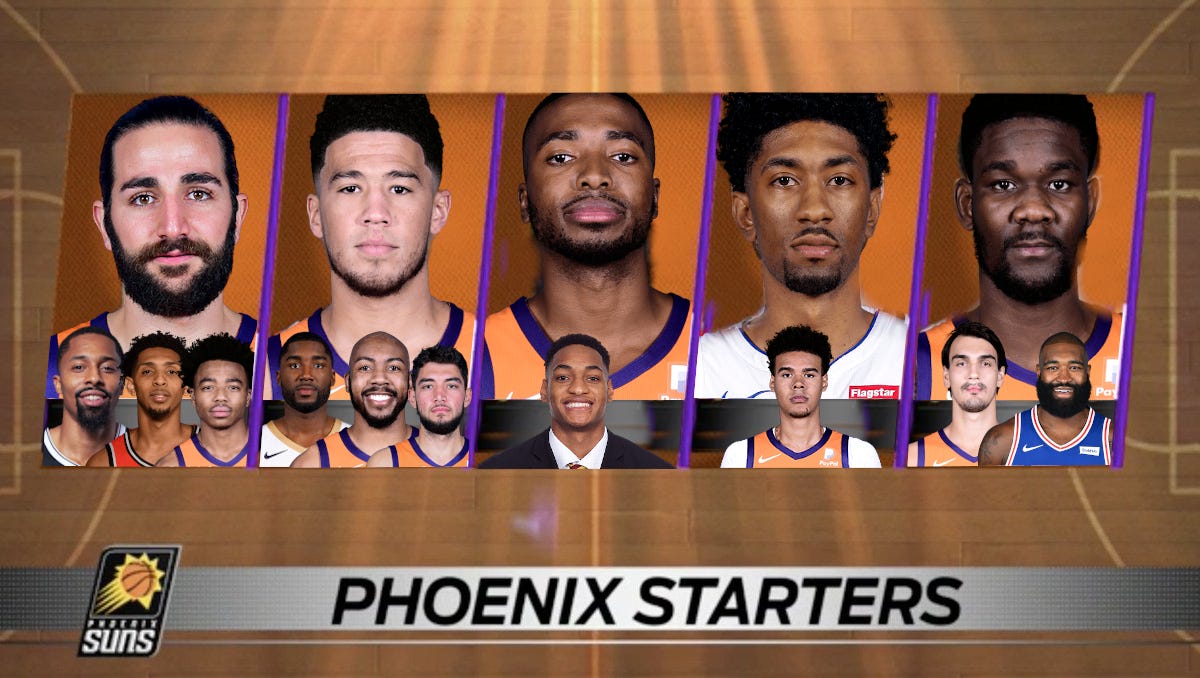
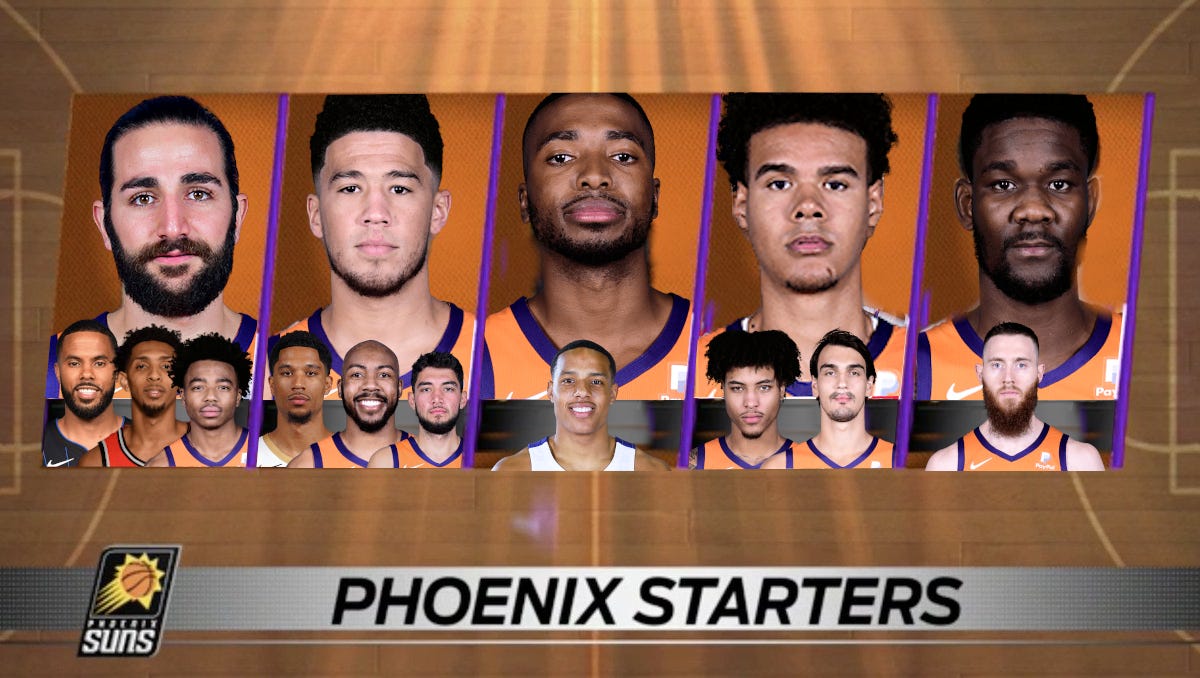
Option 2 would be a home run. Dinwiddie solves a lot of issues as the 6th man. Back up PG/SG and bench scoring. I really doubt the Nets would give up LeVert.
The best of part of this offseason is that the Suns have many ways to do well, and this issue shows it. The 3 options are very different but, without a doubt they all improve the team.
Great issue, interesting and didatic as always. The type of contente that I love.